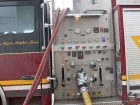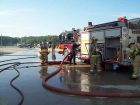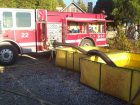
Features
Training
Back to Basics: November 2015
The final part of this series on the basic skills of engine companies to get water to and on the fire focuses on the process by which water is sent to the nozzle from the truck.
November 11, 2015
By Mark van der Feyst
Two key people involved in this step of the process are the pump operator/driver and the nozzle person. Good communication between these two firefighters is paramount in to avoid interruption of suppression activities.
Parts 1 and 2 of this series (which can be read here) covered the steps necessary to secure the water supply, pull off the preconnect hand line and advance the preconnect to the structure’s front door. These are basic skills, but are vital to execute with proficiency in order to prevent the interruption of suppression efforts.
At this point in the operation, the pump operator can easily send water to the nozzle from the onboard water tank. The goal is to get water as quickly as possible to the nozzle for a fast attack or an aggressive interior attack.
Every fire truck that is equipped with a pump and hose will have an onboard water supply; the volume of water supply available depends on departmental specifications. Typically the supply is about 500 gallons, which is enough water for firefighters to initiate an interior attack with a 38- or 45-milimetre (1 1/2-inch or 1 3/4-inch) hand line.
A 65-milimetre (2 1/2-inch) hand line can also be used with the onboard water supply, but it will not last as long as the smaller hand line.
The pump panel (see photo 1) of a fire truck can look confusing to those who are not familiar with it, but with lots of practice and hands-on training, firefighters will learn that it is simple to operate. No matter what type of fire truck you are using, the principles of operating a pump are the same even if the layout of gauges, buttons and levers is different.
The pump operator (see photo 2) sends water to the pump from the onboard water tank by opening the tank-to-pump valve located on the panel. Once water has entered into the pump, the corresponding valve for the hand line is opened when requested by the nozzle person.
Once the hose has been flaked out and is ready to be charged, the nozzle person informs the pump operator by radio, yelling or using hand gestures to indicate that it is time to send the water. A commonly used gesture is one hand raised in the air with the index finger pointing up and the whole hand moving in a circular fashion.
Once the hand line is charged, the pump operator increases the pump pressure in the hand line as required for interior fire-suppression activities. The pump operator dictates pump pressure by hydraulic calculations done on the spot. These numbers are usually pre-determined based on the preconnected hand lines. For example, a 60-metre (200-foot) 1 3/4-inch hand line with an automatic combination nozzle might use a pump pressure set between 900 and 1,000 kilopascals (130 to 140 pounds per square inch).
Once there is water flowing with adequate pump pressure, the pump operator sets up the water supply so that the water can continue to flow when the water in the tank starts to run low.
Depending on the type of water supply being used – hydrant or draft operation – the pump operator will either be able to accomplish the next steps himself or will need help from another firefighter to complete the task.
If a hydrant supply is being used, the pump operator can complete the water set up to the fire truck pump intake by grabbing the large-diameter hose off the back of the truck and connecting it into the intake valve. If the hydrant was properly secured, then this is the only step necessary for the pump operator to complete the water set up.
Once connected to the pump intake, the operator then signals to the hydrant person to send water.
If a portable water tank and rural water operations are being used (see photo 3), firefighters must pull the water tank off the truck (whether it is on the same truck or on a different truck) and open it up beside the pump panel. The ideal area is flat ground with a tarp spread out.
The hard suction hose is then connected from the intake of the pump going into the water tank, with a suction device of some sort attached to the other end. For a water tank set up, this device is usually a flat, pancake-style, but a floating style can also be used. Once the water tank is set up with the hard suction hose in place, water can be dumped into it from the tenders on site.
At this point, the hand lines are charged and flowing water, the water supply is established, and the pump operator is now keeping an eye on the operation of the pump to make sure nothing goes awry.
Mark van der Feyst has been in the fire service since 1999 and is a full-time firefighter in Ontario. Mark teaches in Canada, the United States and India. He is a local-level suppression instructor for the Pennsylvania State Fire Academy and an Instructor for the Justice Institute of BC. He is also the lead author of Pennwell’s Residential Fire Rescue book. Mark@FireStarTraining.com
Print this page


